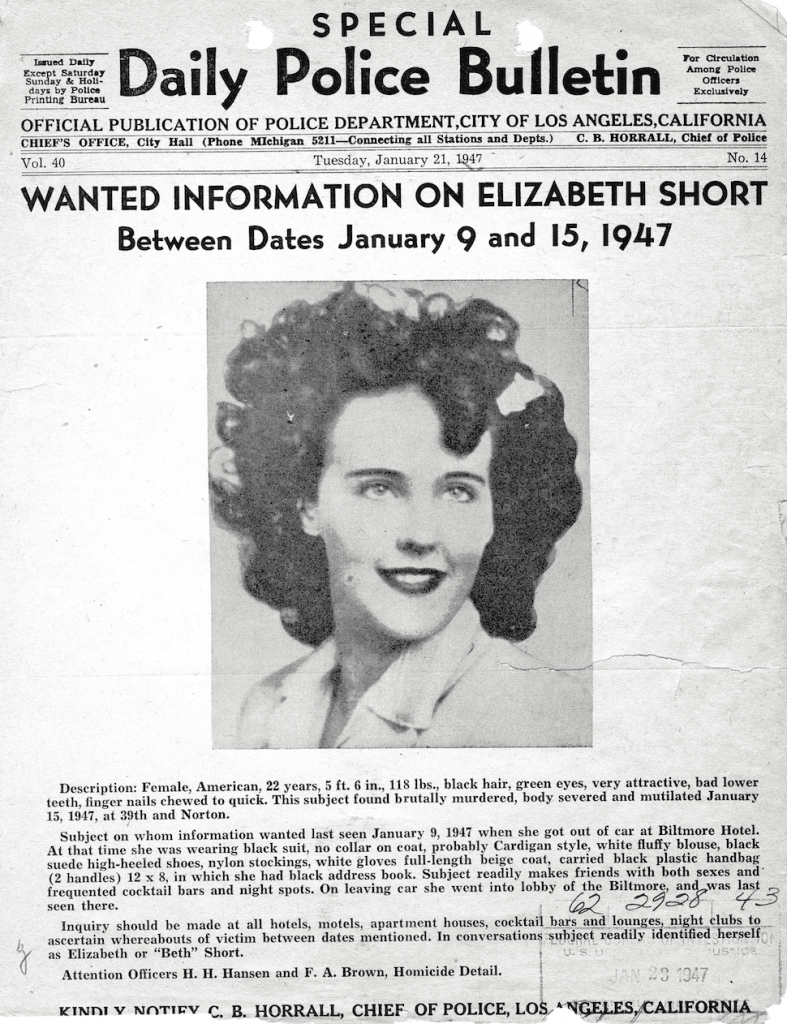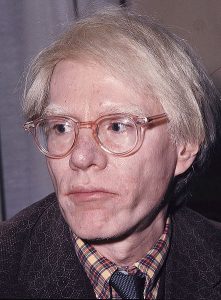Winner of the Fall 2019 StMU History Media Award for
Best Article in the Category of “Crime”
Elizabeth Short, widely known as The Black Dahlia, was a young 22-year-old American woman who was raped, brutally murdered, dismembered, and thrown on a vacant lot in a Los Angeles suburb for everyone to see. Elizabeth’s murder took place in Los Angeles County on January 15, 1947. No one knows the exact events that led to Elizabeth Short’s last moments when she fought for her life. There was no murder confession, and there was a lack of evidence to lead investigators further. Sadly, Elizabeth Short and her family never saw justice for her brutal murder. To this day, the case of The Black Dahlia is still unsolved. A man named Steve Hodel believed that The Black Dahlia murder was in fact not unsolved. Steve Hodel, a former detective, believed he had solved one of Los Angeles’ most notorious murders—but the infamous, troubled, charismatic doctor that Steve Hodel accused for being Short’s murderer, happened to be his own father, George Hodel.1
Elizabeth Short aspired to be an actress, and her young life was full of drinking and partying. She was very attracted to men and the sexual connections that came with men. Short had a desire to attend nightspots and nightclubs. Going to these nightspots, she frequently drew attention to herself, and she was arrested on September 23, 1943 for underage drinking of alcohol. She was only nineteen.2 By this time, Elizabeth had achieved a reputation as an aspiring actress who would go to bed with anyone who could possibly offer her a part in a movie.3 But her lifestyle soon led her to have a horrible encounter with a horrible man.

January 15, 1947 was just like any other day in the Los Angeles area. It was especially cool and overcast, which set the mood for the horrific discovery later that morning. A woman walking with her young daughter caught a glimpse of white flesh through a clump of brown grass in a vacant lot just a few inches from the sidewalk.4 They stumbled across the horrific sight of Elizabeth Short’s naked body cut in half just above the hipbone, drained of blood and arranged as if on display, with her legs spread and arms raised at right angles above her head. In a gruesome addition, two knife gashes extended her mouth up towards her ears.5 Her body also had the letters “B D” carved deeply into one thigh, and these letters were believed to represent the initials of Elizabeth Short’s well-known nickname Black Dahlia.6 This name stuck with her because of her tendency to always wear black clothing that contrasted with her white complexion, as well as having a dahlia flower in her hair on most occasions.7

George Hodel seemed to be an extraordinary man. He was a phenomenal doctor with a very respected reputation. Due to the extensive dismembering and perfect cuts discovered on Elizabeth’s body, her murderer had to have been a doctor.8 A couple years after the Black Dahlia murder, in 1949, Dr. Hodel’s reputation was left in tatters when he was tried for incest with his daughter Tamar Hodel, Steve Hodel’s half-sister.9 This trial brought light to George Hodel’s name in the police department. Because everyone knew that he was a very talented doctor, Dr. Hodel was put at the top of the suspect list for Elizabeth Short’s murder. Due to police corruption at the time, Dr. Hodel’s possible guilt was not presented to the public.
Dr. Hodel ended up passing away on May 16, 1999 due to a heart attack.10 Upon his passing, his son Steve Hodel began an intensive investigation into his father’s past. Steve Hodel made the trip to his father’s home to gather his father’s assets. While looking through his father’s belongings, Steve came across a tiny, palm-sized wood-bound photo album, with twelve golden fleurs-de-lys imprinted on the front.11 Inside this photo album, Steve discovered a number of strange photos of many familiar women. One of the women looked very similar to the Black Dahlia, Elizabeth Short. There were two photos of this women. In one, the woman had paper dahlia flowers in her hair. In the other, the woman was nude with her eyes shut.12 After Steve realized that the women in his father’s old photo album was the Black Dahlia, he became determined to find answers, to possibly clear his father’s name in the eyes of the law. Shortly into his private investigation, Steve Hodel realized that the evidence he was uncovering led to his father’s obvious guilt, not his exoneration. Now he wanted only to do all he could to prove it.
When Steve Hodel started the investigation into his father’s connection to the murder of the Black Dahlia, he found a substantial amount of sufficient yet circumstantial evidence against him. He soon found out that his father and Elizabeth Short knew each other. They had met in 1944 and had begun a non-sexual relationship. George would provide Elizabeth with financial aid for food and rent whenever she needed it in return for showing love interest in George. Steve’s suspicions of his father’s guilt skyrocketed when he came to find out that Elizabeth and his father were together at a downtown hotel three days before Elizabeth’s body was found. During the course of Steve Hodel’s investigation, he recognized his father’s unique handwriting multiple times, especially on the original note mailed by the Black Dahlia Avenger to the LAPD and to the press. The note with his father’s handwriting read “Here it is; Turning in Wed; Jan. 29 10 A.M.; Had my fun at police; Black Dahlia Avenger.” This was the first note that the Black Dahlia Avenger made no attempt to distort or conceal his actual handwriting.13 Hand writing analysis has since confirmed these claims. Although this evidence is circumstantial, Steve Hodel was very passionate in proving his father’s guilt. Another piece of incriminating evidence was a white-faced military watch that Dr. Hodel was seen wearing in contemporary photographs. A similar watch was found in the vacant lot close to where Elizabeth’s body was found.14
A number of men and one woman confessed to the crime, but none of them were able to match the gory details of the slaying known only by the police.15 Elizabeth’s murder seemed to bring out the worst among the psychologically disturbed in the Los Angeles area. The police were overwhelmed with the number of people who confessed to the murder.16 Despite all of these possible killers, Steve Hodel still truly believes that George Hodel was the guilty one.

The former detective for the LAPD and George Hodel’s son, Steve Hodel, had concluded his investigation on his father’s guilt, and developed an accurate timeline and detailed insight into Elizabeth Short’s last moments. Steve Hodel believes that the torture began on January 14, 1947 around 3:00-4:00 PM. Around this time, George Hodel took Elizabeth Short to the Franklin House. He gagged her mouth, bound her hands and feet with rope, and then began a prolonged and systematic process in which Elizabeth was beaten and subjected to ritualistic and sadistic torture.17 The torture included, but was not limited to the infliction of minor cuts to her body. She was beaten and kicked about her entire body, and she was forced to eat her own or his fecal excrement. Large pieces of flesh were cut from Elizabeth’s body and inserted into her orifices. Her face and breasts were also cut to imitate two of Man Ray’s famous photographs.18 Following this unimaginable torture, George Hodel then proceeded to sexually assault the then-slain Elizabeth Short.19 Although Elizabeth Short’s murderer was never convicted, it is now widely believed that George Hodel is the guilty one. The case of the Black Dahlia is considered an unsolved murder to this day, which makes it the most horrific unsolved murder in American history.20 Steve Hodel did not start his investigation until after George Hodel passed away, and only then because he passed away. George Hodel got away with his crime for over forty years. And even if he had not passed away until later in his life, face it, he still probably wouldn’t have ever been held to pay for his crime.
- Grace Bradberry, “My father was the Black Dahlia killer,” The Times, April 24, 2003. ↵
- Steve Hodel, Black Dahlia Avenger: A Genius for Murder (New York: Arcade Pub., 2003), 18. ↵
- Spectacular Crimes of the 1940s, 2007, s.v. “The Black Dahlia Case.” ↵
- Steve Hodel, Black Dahlia Avenger: A Genius for Murder (New York: Arcade Pub., 2003), 10. ↵
- Grace Bradberry, “My father was the Black Dahlia killer,” The Times, April 24, 2003. ↵
- Women in World History: A Biographical Encyclopedia, 2002, s.v. “Short,Elizabeth(1925–1947),” by Anne Commire. ↵
- Women in World History: A Biographical Encyclopedia, 2002, s.v. “Short,Elizabeth(1925–1947),” by Anne Commire. ↵
- Grace Bradberry, “My father was the Black Dahlia killer,” The Times, April 24, 2003. ↵
- Grace Bradberry, “My father was the Black Dahlia killer,” The Times, April 24, 2003. ↵
- Steve Hodel, Black Dahlia Avenger: A Genius for Murder (New York: Arcade Pub., 2003), 22. ↵
- Steve Hodel, Black Dahlia Avenger: A Genius for Murder (New York: Arcade Pub., 2003), 36. ↵
- Grace Bradberry, “My father was the Black Dahlia killer,” The Times, April 24, 2003. ↵
- Steve Hodel, Black Dahlia Avenger: A Genius for Murder (New York: Arcade Pub., 2003), 273. ↵
- Steve Hodel, Black Dahlia Avenger: A Genius for Murder (New York: Arcade Pub., 2003), 445. ↵
- Women in World History: A Biographical Encyclopedia, 2002, s.v. “Short, Elizabeth (1925–1947),” by Anne Commire. ↵
- Spectacular Crimes of the 1940s, 2007, s.v. “The Black Dahlia Case.” ↵
- Steve Hodel, Black Dahlia Avenger: A Genius for Murder (New York: Arcade Pub., 2003), 434. ↵
- Steve Hodel, Black Dahlia Avenger: A Genius for Murder (New York: Arcade Pub., 2003), 445. ↵
- Steve Hodel, Black Dahlia Avenger: A Genius for Murder (New York: Arcade Pub., 2003), 434. ↵
- Women in World History: A Biographical Encyclopedia, 2002, s.v. “Short, Elizabeth(1925–1947),” by Anne Commire. ↵



115 comments
Aqsa Khan
I had never heard about Elizabeth Short before this article, but seeing how brutal her murder was it’s shocking that I never heard of it. She got murdered in such a brutal way and her body was left to be seen by anyone. If I were to ever witness a body, I wouldn’t know how to live with myself, so the lady who saw her was probably so traumatized. It’s crazy that she was killed by a doctor because doctors are supposed to save lives but ironically he killed her instead, but he did seem kind of twisted in the head seeing as how he already tried to incest with his daughter.
Alison Morales-Aguilar
The murder of Elizabeth Short is heartbreakingly sad and it is even sadder that a lot of people know her only as the Black Dahlia. I appreciate that you provided information about her life previously though I do agree with Savannah that her underaged drinking shouldn’t be looked at as bad. I’m sure there’s been a lot of underaged drinkers who have gone through this same experience as Elizabeth.
Aracely Beltran
Being 22 years old this terrifies me. The pain she must have gone through! I am sure the person who found her was also traumatized for life. The police should have put two and two together but I mean like the article mentions corruption… It is a great article and I understand why you won the award! the first paragraph is so interesting!
Savannah Alcazar
Prior to this article, I had not heard of the case of Elizabeth Short. As a 21 year old woman, soon to be 22, I could not imagine my life being taken from me. My family would be distraught, especially if there were no justice. My heart goes out to those that love her. I think the “underage drinking” comment shouldn’t have defined her. Teen drinking is illegal in America of course, but it is quite common. Kids have fake IDs nowadays then turn into doctors.
Arsema Abera
This article was weird and complicated. It was also scary. It’s amazing that a son would be committed to proving his father’s guilt rather than his innocence. It’s sad reading that the murder was a cold case and that nothing was done to serve the justice that this poor girl deserved.
gidget
I don’t know why you would write that this woman was promiscuous and that she drank a lot…I have read otherwise, that she was not promiscuous and that she did not drink alcohol. It is such a shame to hear such nasty accusations about a lovely young girl who was just trying to survive outside of her hometown.
Melanie Fraire
Elizabeth’s murder was so gruesome and disturbing, it’s very upsetting that Dr. Hodel was never convicted for it or that the police even made an attempt at investigating. This was my first time reading about this tragic murder and I found it to be interesting especially because of how people considered it to be “unsolved” when really nothing much was done to even try and solve it.
Eliane Castorena
I had recently watched a short documentary about the peculiar murder of Elizabeth Short before reading this article. The whole case is really suspicious from the gruesome murder to the inconclusive investigation. It is crazy to think that all the evidence was there that Dr. Hodel committed the murder, but was never charged guilty for there. The article did an excellent job at describing the whole case and its details!
Yuliana Vasquez
What I have read in this article, I was not expecting at all. If this man was guilty, he did an huge amount of torture to this poor woman, from beating her to cutting her in half. That is Just something else because I have read other crime articles and there is nothing like this one. I was very surprised that this man was able to escape this crime for 40 years, and was able to hide that he sexually assaulted her, he was smart.
Antonio Holverstott
This crime was the product of a corrupt mind and will to commit horrendous acts such as this murder. The police also contributed to this crime by allowing the murderer to not face prosecution for another crime involving sexual abuse. A successful prosecution would have placed him in prison to prevent him from harming others. And if they were not able to get a conviction, the police should have been able to watch the doctor very closely in order to prevent any more crimes since the person he was in a relationship with was notable.